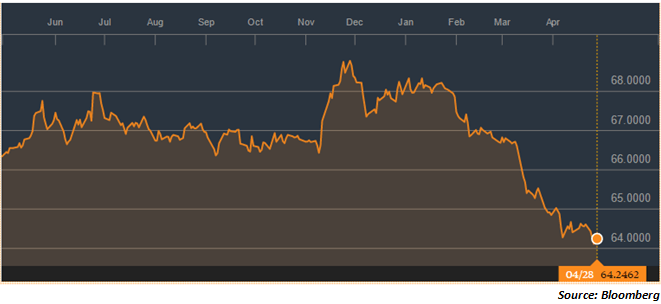One of the big economic stories of the last 3 months has been the strength of the rupee. In fact, back in December 2016 when the INR had touched a low of 68.77/$, most analysts had predicted a weakening of the INR towards the 72/$ mark. Surprisingly, the rupee strengthened and has gained sharply closer to the 64/$ mark. The chart below captures the strength of the INR, as it quotes at a 21-month high.

So, what exactly has spurred the strength in the INR? Firstly, the demonetization did not prove to be as negative for GDP growth as was originally anticipated. With remonetization commencing in January 2017, the positive effects of liquidity are expected to show up rapidly on growth. Secondly, FDI flows have sustained during this period and India has attracted more FDI than China during the last financial year. This has helped the rupee strengthen. Thirdly, the negative impact of FPI outflows ($12.5 billion between Oct 2016 and Jan 2017) was largely compensated by inflows from domestic institutions. All these contributed to the strength of the rupee.
What are the key economic implications of the strengthening rupee?
- For an economy like India that relies on imports for more than 80% of its daily crude requirement, the strong rupee comes as a major blessing in disguise. A stronger rupee means lower landed cost of crude oil, which is anyways expressed in dollar terms. A lower landed cost of oil will not only be anti-inflationary but will also reduce the burden on the government finances. Remember, most Indian companies have managed to sustain OPMs in the last few quarters due to the dollar effects of cheap oil.
- On the subject of government finances, the fiscal deficit and the revenue deficit are largely driven by the INR movement versus the dollar. Lower oil import bill means that India can afford to run a lower revenue deficit as well as a lower fiscal deficit. That explains why the government can afford to focus on fiscal discipline. When fiscal deficit and revenue deficit are in control, it is positive from the perspective of external credit ratings for the economy.
- Import intensive sectors tend to benefit. A stronger rupee makes imports more favourable and is especially suitable for sectors like capital goods and telecom where there is a strong import component. A strong rupee makes imports cheaper and generally tends to be positive for import intensive sectors. However, in case of industries like gems & jewellery and textiles, where there is an export component, the benefits of cheaper imports tend to get neutralized.
- On the other hand, export driven sectors like IT, textiles and pharma tend to suffer from a strong rupee. At a level of 68/$, the INR was already overpriced in REER (real effective exchange rate) terms. REER captures whether the currency is overpriced or underpriced in fundamental terms. A currency that is strong in REER terms needs to depreciate. On the contrary the INR has appreciated despite being overpriced in REER terms. That has put exporters under strain. A strong rupee implies that exports become more expensive and that is normally a case of losing competitiveness to other competing nations. In fact, commodity economies like Brazil and Russia which saw their currencies depreciating have seen their exports picking up rapidly as exports have become cheaper in dollar terms.
- Foreign portfolio flows are largely predicated on the strength of the INR. FPIs have pumped in nearly $14.5 billion into debt and equity between February and April this year. This is largely due to a strong rupee. A strong rupee means that FPIs do not lose out their nominal gains due to currency depreciation. A strengthening INR induces FPIs to rush into India as they get the dual benefit of above average nominal returns and currency dividends. This works as a cycle wherein a strong rupee attracts more FPI flows and these FPI flows in-turn make the INR stronger.
- Apart from FPI flows, FDI flows have also been robust in the last 2 years. One of the reasons is that since Dr. Raja took over at the helm of the RBI in mid-2013, the unstated policy has been to either keep the INR stable or let it depreciate in a calibrated manner. This has made the INR movement predictable and therefore FDI investors are able to factor in the currency risk more scientifically into their calculations. Since FDI investors are long term investors, a predictable trajectory of the INR is critical. That has helped FDI flows substantially and it is hardly surprising that India has become the largest recipient of FDI; bettering even China last year.
When one weighs the relative benefits of a strong INR versus a weak INR, there appears to be clear benefits favour a strong INR. Traditionally, unless you are an export driven economy like the South East Asian miracle economies, a weak currency destroys more value. For India, a strong INR is favourable not only for its macros, but also for its capital and portfolio flows. Not surprising that the RBI has not been overtly intervening to stem the strength in the INR. That could be the paradigm going ahead!

